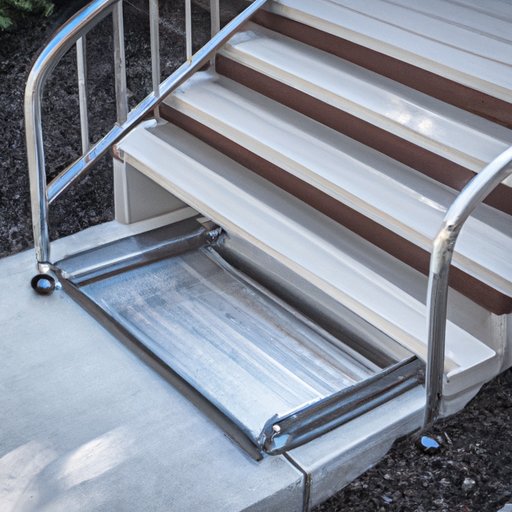Overview of Aluminum Handicap Ramps: Benefits, Features and Installation Tips
Handicap ramps are an essential feature in any public building or home that is used by individuals with physical disabilities. They provide access to areas that may otherwise be inaccessible due to a lack of stairs or other obstacles. Aluminum handicap ramps offer a number of benefits, including durability, easy installation and low maintenance costs. In this article, we’ll explore the benefits, features and installation tips of aluminum handicap ramps.
Benefits of Aluminum Handicap Ramps
Aluminum handicap ramps offer a number of advantages over other materials. First, they are lightweight yet extremely durable. This makes them easy to install and transport, while also providing a long-lasting solution. Additionally, aluminum is resistant to rust and corrosion, so it can withstand even the harshest weather conditions. Finally, aluminum is a very cost-effective material, making it an attractive option for those on a budget.
Features of Aluminum Handicap Ramps
Aluminum handicap ramps come in a variety of sizes and styles, making them highly customizable. Most models feature adjustable legs that allow you to change the height of the ramp to suit your needs. Additionally, many ramps feature non-slip surfaces to ensure maximum safety. This is especially important if the ramp will be used in wet or icy conditions.
Tips for Installing Aluminum Handicap Ramps
Installing an aluminum handicap ramp is relatively simple, but it’s important to take the proper precautions. First, make sure the surface is level and free of debris. Then, use a spirit level to check the ramp for any dips or bumps. Finally, use appropriate fasteners and anchors to secure the ramp in place. It’s also important to keep an eye out for any signs of wear and tear, as these could affect the safety of the ramp.

Cost Comparison: Wood vs Aluminum Handicap Ramps
When it comes to choosing the right material for a handicap ramp, there are a few factors to consider. One of the most important is cost. Let’s compare wood and aluminum to see which might be the better option.
Initial Cost
When it comes to initial cost, wood is usually the more affordable option. However, aluminum is often cheaper when factoring in long-term costs. This is because aluminum requires less maintenance, so the savings can add up over time.
Maintenance Costs
Wood ramps require regular maintenance, such as painting and staining, to protect them from the elements. Aluminum ramps, on the other hand, are virtually maintenance-free. This means fewer costs in the long run.
Durability
Aluminum is much more durable than wood, making it the better option for high-traffic areas. Aluminum ramps can withstand heavy weights and inclement weather, whereas wood ramps are more susceptible to damage. This makes aluminum a safer and more reliable choice.
Safety First: How to Choose the Right Aluminum Handicap Ramp
When selecting an aluminum handicap ramp, there are a few key factors to keep in mind. These include ramp length, width and slope.
Ramp Length
The length of the ramp should be based on the height of the area you’re trying to access. Generally speaking, the longer the ramp, the gentler the slope. This makes it easier and safer for wheelchair users to navigate the ramp.
Ramp Width
The width of the ramp should be at least 36 inches to accommodate wheelchairs and walkers. This allows plenty of room for maneuvering, which is essential for safety.
Ramp Slope
Finally, the slope of the ramp should be no greater than 1:12. This means that for every inch of height, the ramp should span 12 inches in length. A steeper slope can be dangerous and make it difficult for wheelchair users to navigate the ramp.

DIY Guide to Installing an Aluminum Handicap Ramp
If you’re looking to install your own aluminum handicap ramp, here are a few tips to help you get started.
Assembling the Ramp
Begin by assembling the ramp according to the manufacturer’s instructions. Make sure all parts are securely connected and double-check to make sure everything is in place.
Securing the Ramp
Once the ramp is assembled, it’s time to secure it in place. Use appropriate anchors and fasteners to ensure the ramp won’t move or shift. Additionally, you may want to add additional supports to provide extra stability.
Finishing Touches
Finally, add any finishing touches such as handrails or ramps. This will help provide extra support for wheelchair users as they navigate the ramp. It’s also a good idea to add non-slip strips to provide added traction in wet or icy conditions.

Best Practices for Maintaining Aluminum Handicap Ramps
Aluminum handicap ramps require minimal maintenance, but there are still a few best practices to keep in mind.
Regular Cleaning
To keep your aluminum ramp in top condition, it’s important to clean it regularly. Use a mild detergent and warm water to remove dirt and debris. For tougher stains, use a pressure washer with a low-pressure setting.
Inspections & Repairs
It’s also important to inspect the ramp regularly for any signs of wear and tear. If you notice any cracks, bends or other damage, contact a professional for repairs. This will help ensure the ramp remains safe and stable.
Proper Storage
Finally, make sure to store the ramp in a dry, protected area when not in use. This will help extend the life of the ramp and prevent any unnecessary damage.
Maintaining an aluminum handicap ramp is fairly straightforward, but it’s important to take the necessary steps to ensure maximum safety. With the right precautions, you can enjoy the convenience of a durable, affordable aluminum ramp for years to come.

